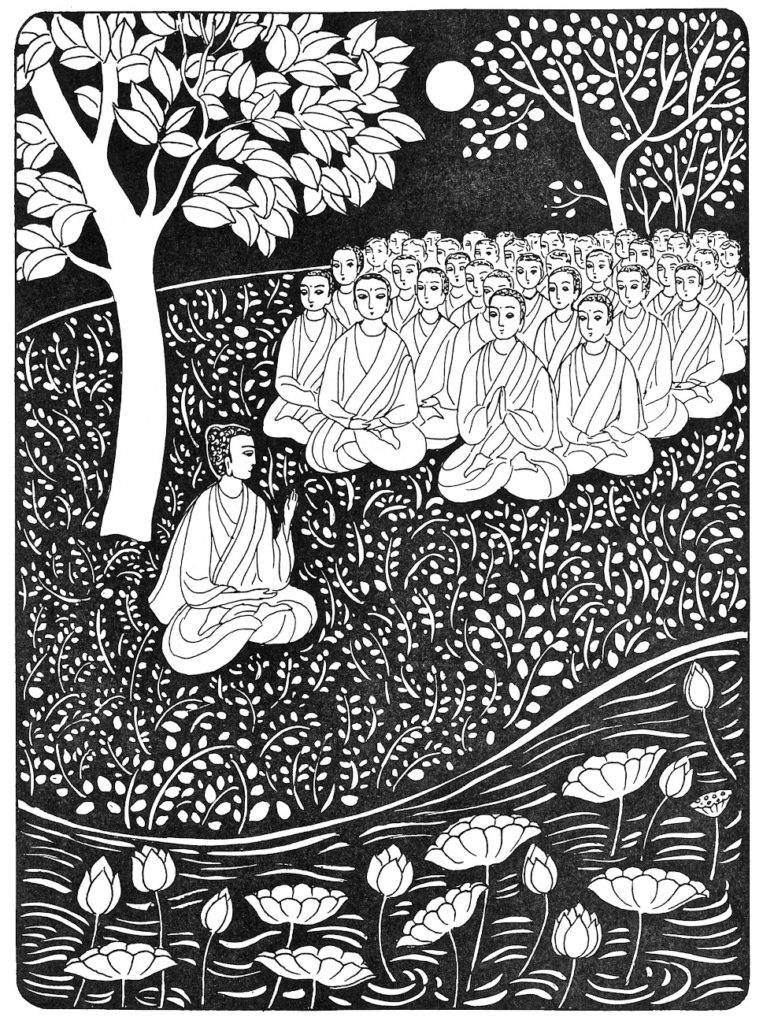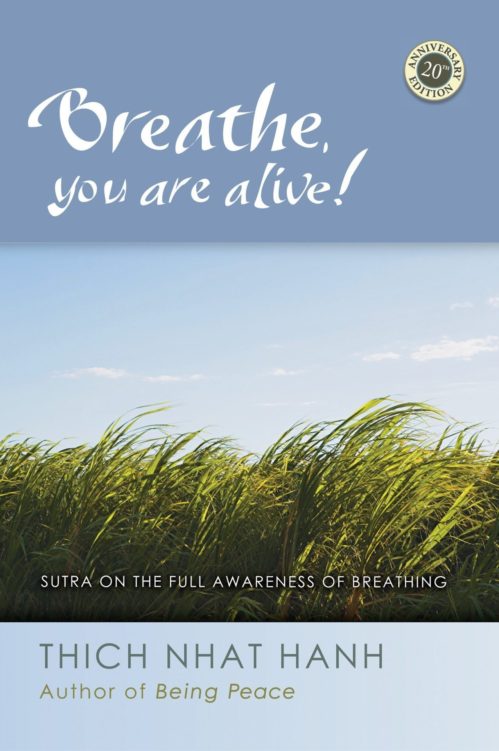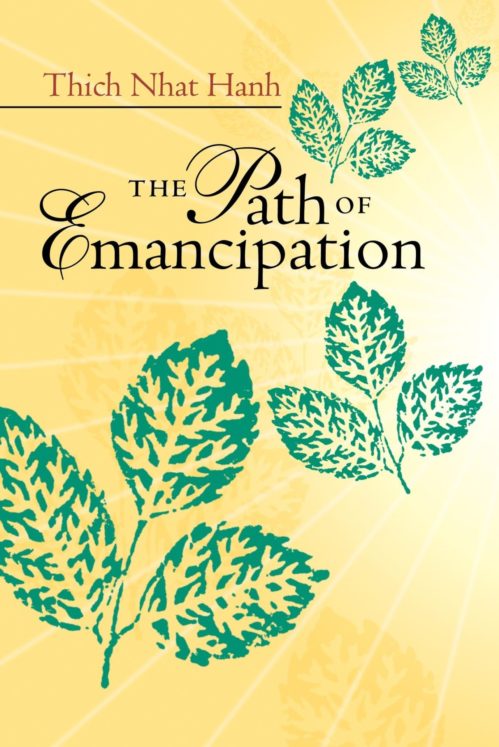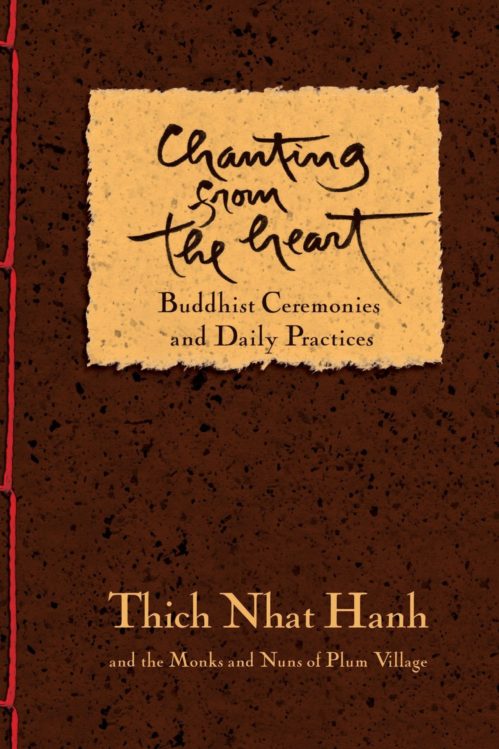
I heard these words of the Buddha one time when he was staying in Savatthi in the Eastern Park, with many well-known and accomplished disciples, including Sariputta, Mahamoggallana, Mahakassapa, Mahakacchayana, Mahakotthita, Mahakappina, Mahachunda, Anuradha, Revata, and Ananda. The senior bhikkhus in the community were diligently instructing bhikkhus who were new to the practice – some instructing ten bhikkhus, some twenty, some thirty, and some forty; and in this way the bhikkhus who were new to the practice gradually made great progress.
That night the moon was full, and the Pavarana Ceremony was held to mark the end of the rainy-season retreat. Lord Buddha, the Awakened One, was sitting in the open air, and his disciples were gathered around him. After looking over the assembly, he began to speak:
“O bhikkhus, I am pleased to observe the fruit you have attained in your practice. Yet I know you can make even more progress. What you have not yet attained, you can attain. What you have not yet realized, you can realize perfectly. (To engage your efforts,) I will remain here until the next full-moon day.”
When they heard that the Lord Buddha was going to remain in Savatthi for another month, bhikkhus throughout the country began traveling there to study with him. The senior bhikkhus continued teaching the bhikkhus new to the practice even more ardently. Some were instructing ten bhikkhus, some twenty, some thirty, and some forty. With this help, the newer bhikkhus were able, little by little, to continue their progress in understanding.
When the next full-moon day arrived, the Buddha, seated under the open sky, looked over the assembly of bhikkhus and began to speak:
“O bhikkhus, our community is pure and good. At its heart, it is without useless and boastful talk, and therefore it deserves to receive offerings and be considered a field of merit. Such a community is rare, and any pilgrim who seeks it, no matter how far he must travel, will find it worthy.
“O bhikkhus, there are bhikkhus in this assembly who have realized the fruit of Arhatship, destroyed every root of affliction, laid aside every burden, and attained right understanding and emancipation. There are also bhikkhus who have cut off the first five internal knots and realized the fruit of never returning to the cycle of birth and death.
“There are those who have thrown off the first three internal knots and realized the fruit of returning once more. They have cut off the roots of greed, hatred, and ignorance, and will only need to return to the cycle of birth and death one more time. There are those who have thrown off the three internal knots and attained the fruit of stream-enterer, coursing steadily to the Awakened State.
There are those who practice:
- the Four Establishments of Mindfulness,
- the Four Right Efforts,
- the Four Bases of Success,
- the Five Faculties,
- the Five Powers,
- the Seven Factors of Awakening,
- the Noble Eightfold Path,
- loving kindness, compassion, joy, and equanimity,
- the Nine Contemplations (on death),
- and the Observation of Impermanence.
There are also bhikkhus who are already practicing Full Awareness of Breathing.”
“O bhikkhus, the Full Awareness of Breathing, if developed and practiced continuously, will be rewarding and bring great advantages. It will lead to success in practicing the Four Establishments of Mindfulness. If the method of the Four Establishments of Mindfulness is developed and practiced continuously, it will lead to success in the practice of the Seven Factors of Awakening. The Seven Factors of Awakening, if developed and practiced continuously, will give rise to understanding and liberation of the mind.
“What is the way to develop and practice continuously the method of Full Awareness of Breathing so that the practice will be rewarding and offer great benefit?
“It is like this, bhikkhus: the practitioner goes into the forest or to the foot of a tree, or to any deserted place, sits stably in the lotus position, holding his or her body quite straight, and practices like this:
‘Breathing in, I know I am breathing in.
Breathing out, I know I am breathing out.’
- ‘Breathing in a long breath, I know I am breathing in a long breath.
Breathing out a long breath, I know I am breathing out a long breath. - ‘Breathing in a short breath, I know I am breathing in a short breath.
Breathing out a short breath, I know I am breathing out a short breath. - ‘Breathing in, I am aware of my whole body.
Breathing out, I am aware of my whole body.’
He or she practices like this. - ‘Breathing in, I calm my whole body.
Breathing out, I calm my whole body.’
He or she practices like this. - ‘Breathing in, I feel joyful.
Breathing out, I feel joyful.’
He or she practices like this. - ‘Breathing in, I feel happy.
Breathing out, I feel happy.’
He or she practices like this. - ‘Breathing in, I am aware of my mental formations.
Breathing out, I am aware of my mental formations.’
He or she practices like this. - ‘Breathing in, I calm my mental formations.
Breathing out, I calm my mental formations.’
He or she practices like this. - ‘Breathing in, I am aware of my mind.
Breathing out, I am aware of my mind.’
He or she practices like this. - ‘Breathing in, I make my mind happy.
Breathing out, I make my mind happy.’
He or she practices like this. - ‘Breathing in, I concentrate my mind.
Breathing out, I concentrate my mind.’
He or she practices like this. - ‘Breathing in, I liberate my mind.
Breathing out, I liberate my mind.’
He or she practices like this. - ‘Breathing in, I observe the impermanent nature of all dharmas.
Breathing out, I observe the impermanent nature of all dharmas.’
He or she practices like this. - ‘Breathing in, I observe the disappearance of desire.
Breathing out, I observe the disappearance of desire.’
He or she practices like this. - ‘Breathing in, I observe the no-birth, no-death nature of all phenomena.
Breathing out, I observe the no-birth, no-death nature of all phenomena.’ He or she practices like this. - ‘Breathing in, I observe letting go.
Breathing out, I observe letting go.’
He or she practices like this.
“The Full Awareness of Breathing, if developed and practiced continuously according to these instructions, will be rewarding and of great benefit.”
“In what way does one develop and continuously practice the Full Awareness of Breathing, in order to succeed in the practice of the Four Establishments of Mindfulness?
“When the practitioner breathes in or out a long or a short breath, aware of his breath or his whole body, or aware that he is making his whole body calm and at peace — he abides peacefully in the observation of the body in the body, persevering, fully awake, clearly understanding his state, gone beyond all attachment and aversion to this life. These exercises of breathing with Full Awareness belong to the First Establishment of Mindfulness, the body.
“When the practitioner breathes in or out aware of joy or happiness, of the mental formations, or to make the mental formations peaceful — he abides peacefully in the observation of the feelings in the feelings, persevering, fully awake, clearly understanding his state, gone beyond all attachment and aversion to this life. These exercises of breathing with Full Awareness belong to the Second Establishment of Mindfulness, the feelings.
“When the practitioner breathes in or out with the awareness of the mind, or to make the mind happy, to collect the mind in concentration, or to free and liberate the mind — he abides peacefully in the observation of the mind in the mind, persevering, fully awake, clearly understanding his state, gone beyond all attachment and aversion to this life. These exercises of breathing with Full Awareness belong to the Third Establishment of Mindfulness, the mind. Without Full Awareness of Breathing, there can be no development of meditative stability and understanding.
“When the practitioner breathes in or breathes out and contemplates the essential impermanence or the essential disappearance of desire or the no-birth, no-death nature of all phenomena or letting go — he abides peacefully in the observations of the objects of mind in the objects of mind, persevering, fully awake, clearly understanding his state, gone beyond all attachment and aversion to this life. These exercises of breathing with Full Awareness belong to the Fourth Establishment of Mindfulness, the objects of mind.
“The practice of Full Awareness of Breathing, if developed and practiced continuously, will lead to perfect accomplishment of the Four Establishments of Mindfulness.”
“Moreover, if they are developed and continuously practiced, the Four Establishments of Mindfulness will lead to perfect abiding in the Seven Factors of Awakening. How is this so?
“When the practitioner can maintain, without distraction, the practice of observing
the body in the body,
the feelings in the feelings,
the mind in the mind,
and the objects of mind in the objects of mind,
persevering, fully awake, clearly understanding her state, gone beyond all attachment and aversion to this life, with unwavering, steadfast, imperturbable meditative stability, she will attain the First Factor of Awakening, namely mindfulness.
When this factor is developed, it will come to perfection.
“When the practitioner can abide in meditative stability without being distracted and can investigate every dharma, every object of mind that arises, then the Second Factor of Awakening will be born and developed in her, the factor of investigating dharmas.
When this factor is developed, it will come to perfection.
“When the practitioner can observe and investigate every dharma in a sustained, persevering, and steadfast way, without being distracted, the Third Factor of Awakening will be born and developed in her, the factor of energy.
When this factor is developed, it will come to perfection.
“When the practitioner has reached a stable, imperturbable abiding in the stream of practice, the Fourth Factor of Awakening will be born and developed in her, the factor of joy.
When this factor is developed, it will come to perfection.
“When the practitioner can abide undistractedly in the state of joy, she will feel her body and mind light and at peace. At this point the Fifth Factor of Awakening will be born and developed, the factor of ease.
When this factor is developed, it will come to perfection.
“When both body and mind are at ease, the practitioner can easily enter into concentration. At this point the Sixth Factor of Awakening will be born and developed in her, the factor of concentration.
When this factor is developed, it will come to perfection.
“When the practitioner is abiding in concentration with deep calm, she will cease discriminating and comparing. At this point the Seventh Factor of Awakening is released, born, and developed in her, the factor of letting go.
When this factor is developed, it will come to perfection.
“This is how the Four Establishments of Mindfulness, if developed and practiced continuously, will lead to perfect abiding in the Seven Factors of Awakening.”
“How will the Seven Factors of Awakening, if developed and practiced continuously, lead to the perfect accomplishment of true understanding and complete liberation?
“If the practitioner follows the path of the Seven Factors of Awakening, living in quiet seclusion, observing and contemplating the disappearance of desire, he will develop the capacity of letting go. This will be a result of following the path of the Seven Factors of Awakening and will lead to the perfect accomplishment of true understanding and complete liberation.”
This is what the Lord, the Awakened One, said; and everyone in the assembly felt gratitude and delight at having heard his teachings.
Remarks
Translated by Thich Nhat Hanh from Ānāpānasati Sutta, Majjhima Nikāya 118.
The Discourse on the Full Awareness of Breathing is one of the most important sutras in the Plum Village tradition, and is taught at every Plum Village retreat. When Thich Nhat Hanh discovered this discourse, he said, “I felt I was the happiest person in the world.”
Thay’s first English translation was published in 1988, and he continued to revise and refine his translation in recent years.








Join the conversation